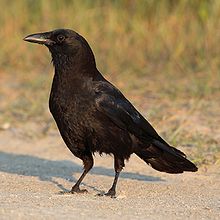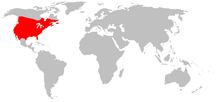American Crow
Facts
Conservation Status: Least Concern
Location: United States of America
Lifespan: 7 to 8 years in wild. Up to 30 years in captivity.
Conservation Status: Least Concern
Location: United States of America
Lifespan: 7 to 8 years in wild. Up to 30 years in captivity.
Scientific Classification
Kingdom: Animalia
Phylum: Chordata
Class: Aves
Subclass: Neornithes
Infraclass: Neognathae
Superorder: Neoaves
Order: Passeriformes
Suborder: Passeri
Superfamily: Corvoidea
Family: Corvidae
Genus: Corvus
Species: C. brachyrhynchos
Binomial name: Corvus brachyrhynchos
Kingdom: Animalia
Phylum: Chordata
Class: Aves
Subclass: Neornithes
Infraclass: Neognathae
Superorder: Neoaves
Order: Passeriformes
Suborder: Passeri
Superfamily: Corvoidea
Family: Corvidae
Genus: Corvus
Species: C. brachyrhynchos
Binomial name: Corvus brachyrhynchos
Description
Length: 50 cm (16 to 20 in)
Wing length: 27 to 34 cm (11 to 14 in)
Bill Length: 5 cm (2 in)
Other: The American Crow is a distinctive bird with iridescent black feathers all over. Its legs, feet and bill are also black. Males tend to be larger than females.
Length: 50 cm (16 to 20 in)
Wing length: 27 to 34 cm (11 to 14 in)
Bill Length: 5 cm (2 in)
Other: The American Crow is a distinctive bird with iridescent black feathers all over. Its legs, feet and bill are also black. Males tend to be larger than females.
Subspecies
- C. b. brachyrhynchos - Eastern Crow - Northeastern United States, Eastern Canada. Largest subspecies.
- C. b. hesperis - Western Crow - Western North America except arctic north, Pacific Northwest and extreme south. Smaller overall with a proportionally more slender bill and low-pitched voice.
- C. b. pascuus - Florida Crow - Florida. Mid-sized, short-winged but decidedly long bill and legs.
- C. b. paulus - Southern Crow - Southern United States. Smaller overall, bill also small.
Behaviour
The most usual call is a loud, short, and rapid caaw-caaw-caaw. Usually, the birds thrust their heads up and down as they utter this call. American Crows can also produce a wide variety of sounds and sometimes mimic noises made by other animals, including other birds.
The most usual call is a loud, short, and rapid caaw-caaw-caaw. Usually, the birds thrust their heads up and down as they utter this call. American Crows can also produce a wide variety of sounds and sometimes mimic noises made by other animals, including other birds.
Predators or Prey?
Predators of American Crows include hawks, owls, eagles, snakes, raccoons, and man. Almost every small animal is the prey of the American Crow.
Predators of American Crows include hawks, owls, eagles, snakes, raccoons, and man. Almost every small animal is the prey of the American Crow.
Diet
The American Crow is omnivorous. It will feed on invertebrates of all types, carrion, scraps of human food, seeds, eggs and nestlings, stranded fish on the shore and various grains. American Crows are active hunters and will prey on mice, frogs, and other small animals. In winter and autumn, the diet of American Crows is more dependent on nuts and acorns. Occasionally, they will visit bird feeders. The American Crow is one of only a few species of bird that has been observed modifying and using tools to obtain food. Like most crows, they will scavenge at landfills, scattering garbage in the process. Where available, corn, wheat and other crops are a favorite food. These habits have historically caused the American Crow to be considered a nuisance. However, it is suspected that the harm to crops is offset by the service the American Crow provides by eating insect pests.
The American Crow is omnivorous. It will feed on invertebrates of all types, carrion, scraps of human food, seeds, eggs and nestlings, stranded fish on the shore and various grains. American Crows are active hunters and will prey on mice, frogs, and other small animals. In winter and autumn, the diet of American Crows is more dependent on nuts and acorns. Occasionally, they will visit bird feeders. The American Crow is one of only a few species of bird that has been observed modifying and using tools to obtain food. Like most crows, they will scavenge at landfills, scattering garbage in the process. Where available, corn, wheat and other crops are a favorite food. These habits have historically caused the American Crow to be considered a nuisance. However, it is suspected that the harm to crops is offset by the service the American Crow provides by eating insect pests.
Habitat
The range of the American Crow extends from the Pacific Ocean to the Atlantic Ocean in Canada, on the French islands of Saint-Pierre and Miquelon, south through the United States, and into northern Mexico. Virtually all types of country from wilderness, farmland, parks, open woodland to towns and major cities are inhabited; it is absent only from Pacific temperate rain forests and tundra habitat where it is replaced by the raven. This crow is a permanent resident in most of the USA, but most Canadian birds migrate some distances southward in winter. Outside of the nesting season these birds often gather in large communal roosts at night.
The range of the American Crow extends from the Pacific Ocean to the Atlantic Ocean in Canada, on the French islands of Saint-Pierre and Miquelon, south through the United States, and into northern Mexico. Virtually all types of country from wilderness, farmland, parks, open woodland to towns and major cities are inhabited; it is absent only from Pacific temperate rain forests and tundra habitat where it is replaced by the raven. This crow is a permanent resident in most of the USA, but most Canadian birds migrate some distances southward in winter. Outside of the nesting season these birds often gather in large communal roosts at night.
Conservation
Crows have been killed in large numbers by humans, both for recreation and as part of organized campaigns of extermination. American Crows are protected internationally by the Migratory Bird Treaty Act of 1918. Despite attempts by humans in some areas to drive away or eliminate these birds, they remain widespread and very common. The number of individual American Crows is estimated by Birdlife International to be around 31,000,000. The large population, as well as its vast range, are the reasons why the American Crow is considered to be of least concern, meaning that the species is not threatened.
Crows have been killed in large numbers by humans, both for recreation and as part of organized campaigns of extermination. American Crows are protected internationally by the Migratory Bird Treaty Act of 1918. Despite attempts by humans in some areas to drive away or eliminate these birds, they remain widespread and very common. The number of individual American Crows is estimated by Birdlife International to be around 31,000,000. The large population, as well as its vast range, are the reasons why the American Crow is considered to be of least concern, meaning that the species is not threatened.
Reproduction
American Crows are monogamous cooperative breeding birds. Mated pairs form large families of up to 15 individuals from several breeding seasons that remain together for many years. Offspring from a previous nesting season will usually remain with the family to assist in rearing new nestlings. American Crows do not reach breeding age for at least two years. Most do not leave the nest to breed for four to five years. The nesting season starts early, with some birds incubating eggs by early April. American Crows build bulky stick nests, nearly always in trees but sometimes also in large bushes and, very rarely, on the ground. They will nest in a wide variety of trees, including large conifers, although oaks are most often used. Three to six eggs are laid and incubated for 18 days. The young are usually fledged by about 35 days after hatching.
American Crows are monogamous cooperative breeding birds. Mated pairs form large families of up to 15 individuals from several breeding seasons that remain together for many years. Offspring from a previous nesting season will usually remain with the family to assist in rearing new nestlings. American Crows do not reach breeding age for at least two years. Most do not leave the nest to breed for four to five years. The nesting season starts early, with some birds incubating eggs by early April. American Crows build bulky stick nests, nearly always in trees but sometimes also in large bushes and, very rarely, on the ground. They will nest in a wide variety of trees, including large conifers, although oaks are most often used. Three to six eggs are laid and incubated for 18 days. The young are usually fledged by about 35 days after hatching.



